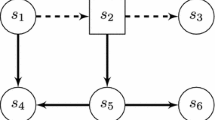Conclusions
-
1)
For the solution of problems of composition and decomposition of nonelementary automata we use a general method which is based on the solution of a system of functional equations.
-
2)
When setting up the system of functional equations we do not impose constraints on the method and level of description of the language of systems.
-
3)
When synthesizing the automata A0, Ai, Bi, the structure of the automaton Ai is not subject to any variation. This is a factor of considerable importance, since here it is possible to have a definite set of automata Ai which enable us to synthesize automata A0 which realize specified functions.
-
4)
The method proposed for the solution of a system of functional equations is applicable for automatization of the design of computer systems.
Similar content being viewed by others
Literature Cited
V. M. Glushkov, Synthesis of Digital Automata [in Russian], Fizmatgiz, Moscow (1962).
M. Fister, Logic Design of Digital Computers [Russian translation], Tekhnika, Moscow (1964).
V. V. Pavlov, Invariance and Autonomy of Nonlinear Control Systems [in Russian], Naukova Dumka, Kiev (1971).
V. V. Pavlov, “Prescriptive theory of ergodic systems,” Avtomatika, No. 1, Kiev (1972).
Additional information
Translated from Kibernetika, No. 1, pp. 31–38, January–February, 1973.
Rights and permissions
About this article
Cite this article
Pavlov, V.V., Obukhov, V.E. Functional synthesis of systems. Cybern Syst Anal 9, 35–44 (1973). https://doi.org/10.1007/BF01068664
Received:
Issue Date:
DOI: https://doi.org/10.1007/BF01068664




